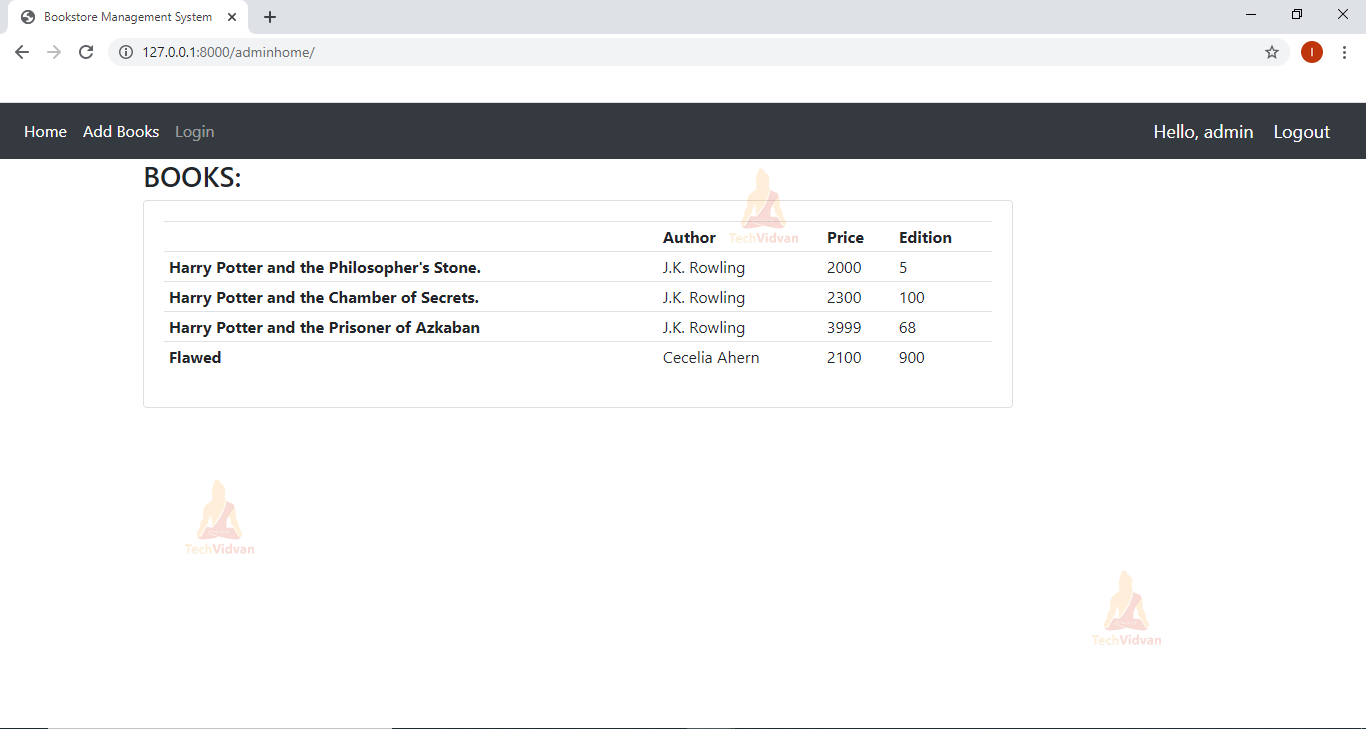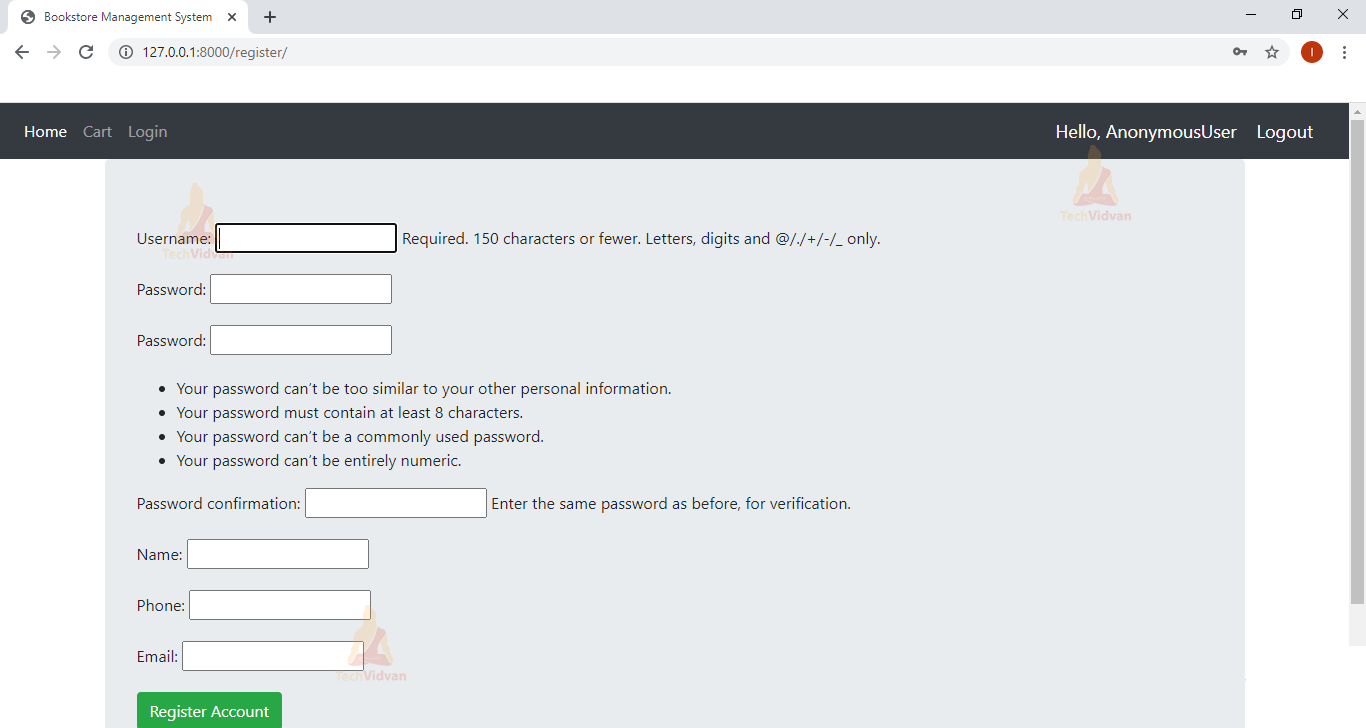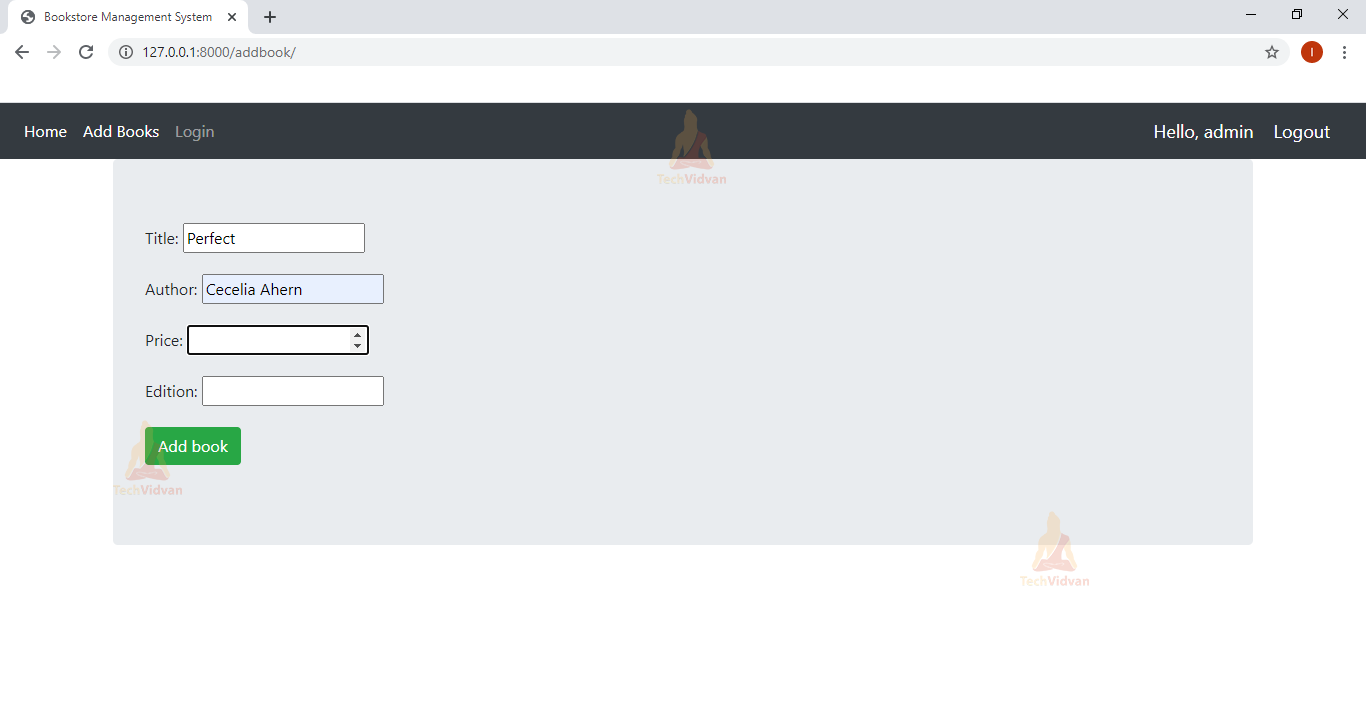Book Store Management System – Python Django Project
Create a simple book store management system project using python django.
The Book store management system is a beginner-level project. We will be using Django (python framework) to develop this project.
Project Prerequisites
We will use the following technologies:
Front-end technologies:
- HTML
- CSS
- Bootstrap
Back-end technologies:
- Python
- Django framework
To install the django, you can use the pip installer from cmd/terminal.
pip install Django
Download Book Store Management System Python Code
Please download the source code of book store project: Book Store Management System Code
Steps to Build the Book Store Project
To start the work on book store project, please run below commands in cmd/terminal
django-admin startproject bookstore cd bookstore django-admin startapp book
1. Writing Models
We are using sqlite3 database (the default database in Django). So we just have to define the classes in models.py file and the tables will be automatically created.
Code:
from django.db import models
from django.contrib.auth.models import User
# Create your models here.
class Book(models.Model):
title=models.CharField(max_length=200,null=True)
Author=models.CharField(max_length=200,null=True)
Price=models.IntegerField()
Edition=models.IntegerField()
def __str__(self):
return str(self.title)
class Customer(models.Model):
user = models.OneToOneField(User, null=True, on_delete=models.CASCADE)
name=models.CharField(max_length=200,null=True)
phone=models.CharField(max_length=200,null=True)
email=models.CharField(max_length=200,null=True)
date_created=models.DateTimeField(auto_now_add=True,null=True)
def __str__(self):
return str(self.name)
class Cart(models.Model):
customer=models.OneToOneField(Customer, null=True, on_delete=models.CASCADE)
books=models.ManyToManyField(Book)
def __str__(self):
return str(self.customer)
Explanation:
Book: This model stores the information related to books like author, title, price, and edition.
Customer: This model stores customer’s name, phone number, email, and date.
Cart: This stores all the books added by a particular customer in his/her cart.
To create tables, run the following commands on cmd/terminal
Py manage.py makemigrations Py manage.py migrate
2. forms.py
Code:
from django.forms import ModelForm
from .models import *
from django.contrib.auth.forms import UserCreationForm
from django.contrib.auth.models import User
class createuserform(UserCreationForm):
class Meta:
model=User
fields=['username','password']
class createcustomerform(ModelForm):
class Meta:
model=Customer
fields='__all__'
exclude=['user']
class createbookform(ModelForm):
class Meta:
model=Book
fields='__all__'
This code is simple because django does it all for us, we are just importing and calling the inbuilt functions in book store project.
3. admin.py
To access, add, delete or modify database entries using admin panel, add the following code in admin.py
Code:
from django.contrib import admin from .models import * # Register your models here. admin.site.register(Book) admin.site.register(Cart) admin.site.register(Customer)
We also need a superuser to access the admin panel. Command to create superuser
py manage.py createsuperuser
It will ask for the superuser name, email and password.
4. urls.py
We will create separate urls.py for each app. Thus, we have to include the new urls.py in the book store project’s urls.py.
Code:
"""bookstore URL Configuration
The `urlpatterns` list routes URLs to views. For more information please see:
https://docs.djangoproject.com/en/3.1/topics/http/urls/
Examples:
Function views
1. Add an import: from my_app import views
2. Add a URL to urlpatterns: path('', views.home, name='home')
Class-based views
1. Add an import: from other_app.views import Home
2. Add a URL to urlpatterns: path('', Home.as_view(), name='home')
Including another URLconf
1. Import the include() function: from django.urls import include, path
2. Add a URL to urlpatterns: path('blog/', include('blog.urls'))
"""
from django.contrib import admin
from django.urls import path,include
urlpatterns = [
path('admin/', admin.site.urls),
path('',include('book.urls')),
]
book/urls.py:
Code:
from django.urls import path
from django.contrib.auth import views as auth_views
from .views import *
urlpatterns =[
path('', home,name='home'),
path('login/', loginPage,name='login'),
path('viewcart/', viewcart,name='viewcart'),
path('addbook/', addbook,name='addbook'),
path('register/', registerPage,name='register'),
path('logout/', logoutPage,name='logout'),
path('addtocart/<str:pk>', addtocart,name='addtocart'),
]
5. views.py:
Code:
from django.shortcuts import render,redirect
from django.http import HttpResponse
from .models import *
from django.contrib.auth import login,logout,authenticate
from .forms import *
# Create your views here.
def home(request):
books=Book.objects.all()
context={'books':books}
if request.user.is_staff:
return render(request,'book/adminhome.html',context)
else:
return render(request,'book/home.html',context)
def logoutPage(request):
logout(request)
return redirect('/')
def loginPage(request):
if request.user.is_authenticated:
return redirect('home')
else:
if request.method=="POST":
username=request.POST.get('username')
password=request.POST.get('password')
user=authenticate(request,username=username,password=password)
if user is not None:
print("working")
login(request,user)
return redirect('/')
context={}
return render(request,'book/login.html',context)
def registerPage(request):
form=createuserform()
cust_form=createcustomerform()
if request.method=='POST':
form=createuserform(request.POST)
cust_form=createcustomerform(request.POST)
if form.is_valid() and cust_form.is_valid():
user=form.save()
customer=cust_form.save(commit=False)
customer.user=user
customer.save()
return redirect('login')
context={
'form':form,
'cust_form':cust_form,
}
return render(request,'book/register.html',context)
def addbook(request):
form=createbookform()
if request.method=='POST':
form=createbookform(request.POST)
if form.is_valid():
form.save()
return redirect('/')
context={'form':form}
return render(request,'book/addbook.html',context)
def viewcart(request):
cust=Customer.objects.filter(user=request.user)
for c in cust:
carts=Cart.objects.all()
for cart in carts:
if(cart.customer==c):
context={
'cart':cart
}
return render(request,'book/viewcart.html',context)
else:
return render(request,'book/emptycart.html')
def addtocart(request,pk):
book=Book.objects.get(id=pk)
cust=Customer.objects.filter(user=request.user)
for c in cust:
carts=Cart.objects.all()
reqcart=''
for cart in carts:
if(cart.customer==c):
reqcart=cart
break
if(reqcart==''):
reqcart=Cart.objects.create(
customer=c,
)
reqcart.books.add(book)
return redirect('/')
We have created seven views in this file:
1. Home
This is the home page for both admin and customer of book store management system. It renders all the ‘book’ objects to templates which displays all the details of the books based on the access rights of the user.
Admin’s home page:
The navbar is also different for both the users. For customers, the view cart option is available and for admin add books option is present. Also the add to cart button is only for customers.
2. Logout:
This view provides the logout functionality.
3. Login:
It first checks whether the user is authenticated or not. If the user is authenticated then it redirects to the home page otherwise it will check the user credentials and then after verifying it will change the state to logged in.
4. Register:
It is very similar to login view. It just creates a new Customer and then it redirects to the login page.
5. Addbook:
This view is just for admin. We are using the createbookform() here which we have already discussed in forms.py section. After adding a book in the database, it redirects to the home page.
6. Viewcart:
It is a customer view. Here we are just rendering the cart of the current user to viewcart.html which displays all the books in the cart. It also checks whether the cart is empty.
7.Addtocart:
This is also a customer view. If the cart of the current user is empty, it will create a new cart for the user. After that it adds the requested book in the cart.
6. templates
Addbook.html
{% extends 'book/main.html' %}
{% load static%}
{% block content %}
<div class="container jumbotron">
<form method="POST" action="" >
{% csrf_token %}
{{form.as_p}}
<input class="btn btn-success" type="submit" value="Add book">
</form>
</div>
{% endblock %}
Emptycart.html
{% extends 'book/main.html' %}
{% load static%}
{% block content %}
<div class="container jumbotron">
<h1>Your cart is empty!!!</h1>
</div>
{% endblock %}
Home.html
{% extends 'book/main.html' %}
{% block content %}
<br>
<div class="container">
<div class="container row">
<div class="col-lg-10">
<h3>BOOKS:</h3>
<div class="card card-body">
<table class="table table-sm">
<tr>
<th><Title></Title></th>
<th>Author</th>
<th>Price</th>
<th>Edition</th>
<th></th>
</tr>
{% for book in books %}
<tr>
<td><b>{{book.title}}</b> </td>
<td>{{book.Author}} </td>
<td>{{book.Price}} </td>
<td> {{book.Edition}} </td>
<td><a class="btn btn-sm btn-info" href="{% url 'addtocart' book.id %}">Add to cart</a> </td>
</tr>
{% endfor %}
</table>
</div>
</div>
</div>
{% endblock %}
Login.html
{% extends 'book/main.html' %}
{% load static%}
{% block content %}
<div class="container jumbotron">
<form method="POST" action="">
{% csrf_token %}
<p><input type="text" name="username" placeholder="Username..."></p>
<p><input type="password" name="password" placeholder="Password..." ></p>
<input class="btn btn-success" type="submit" value="Login">
<p>Do not have an account<a href='{% url 'register' %}'>Register</a></p>
</form>
</div>
{% endblock %}
Main.html
{% load static %}
<html>
<head>
<title>
Bookstore Management System
</title>
<link rel="stylesheet" href="https://stackpath.bootstrapcdn.com/bootstrap/4.5.0/css/bootstrap.min.css" integrity="sha384-9aIt2nRpC12Uk9gS9baDl411NQApFmC26EwAOH8WgZl5MYYxFfc+NcPb1dKGj7Sk" crossorigin="anonymous">
</head>
<body>
{% include 'book/navbar.html' %}
{% block content %}
{% endblock %}
<br>
<script src="https://code.jquery.com/jquery-3.5.1.slim.min.js" integrity="sha384-DfXdz2htPH0lsSSs5nCTpuj/zy4C+OGpamoFVy38MVBnE+IbbVYUew+OrCXaRkfj" crossorigin="anonymous"></script>
<script src="https://cdn.jsdelivr.net/npm/[email protected]/dist/umd/popper.min.js" integrity="sha384-Q6E9RHvbIyZFJoft+2mJbHaEWldlvI9IOYy5n3zV9zzTtmI3UksdQRVvoxMfooAo" crossorigin="anonymous"></script>
<script src="https://stackpath.bootstrapcdn.com/bootstrap/4.5.0/js/bootstrap.min.js" integrity="sha384-OgVRvuATP1z7JjHLkuOU7Xw704+h835Lr+6QL9UvYjZE3Ipu6Tp75j7Bh/kR0JKI" crossorigin="anonymous"></script>
</body>
</html>
Navbar.html
{% load static %}
<style>
.hello-msg{
font-size: 18px;
color: #fff;
margin-right: 20px;
}
</style>
<nav class="navbar navbar-expand-lg navbar-dark bg-dark">
<button class="navbar-toggler" type="button" data-toggle="collapse" data-target="#navbarNav" aria-controls="navbarNav" aria-expanded="false" aria-label="Toggle navigation">
<span class="navbar-toggler-icon"></span>
</button>
<div class="collapse navbar-collapse" id="navbarNav">
<ul class="navbar-nav">
<li class="nav-item active">
<a class="nav-link" href="{% url 'home' %}">Home</a>
</li>
{% if request.user.is_staff %}
</li>
<li class="nav-item active">
<a class="nav-link" href="{% url 'addbook' %}">Add Books</a>
</li>
{% else %}
<li class="nav-item">
<a class="nav-link" href="{% url 'viewcart' %}">Cart</a>
</li>
{% endif %}
<li class="nav-item">
<a class="nav-link" href="{% url 'login' %}">Login</a>
</li>
</ul>
</div>
<span class="hello-msg">Hello, {{request.user}}</span>
<span ><a class="hello-msg" href="{% url 'logout' %}">Logout</a></span>
</nav>
Register.html
{% extends 'book/main.html' %}
{% load static%}
{% block content %}
<div class="container jumbotron">
<form method="POST" action="" >
{% csrf_token %}
{{form.as_p}}
{{cust_form.as_p}}
<input class="btn btn-success" type="submit" value="Register Account">
</form>
</div>
{% endblock %}
Viewcart.html
{% extends 'book/main.html' %}
{% load static%}
{% block content %}
<div class="container">
<div class="row">
<div class="col-lg-10">
<br>
<h5>BOOKS:</h5>
<div class="card card-body">
<table class="table table-sm">
<tr>
<th>Title</th>
<th>Author</th>
<th>Price</th>
<th>Edition</th>
</tr>
{% for book in cart.books.all %}
<tr>
<td>{{book.title}} </td>
<td>{{book.Author}} </td>
<td>{{book.Price}} </td>
<td>{{book.Edition}} </td>
</tr>
{% endfor %}
</table>
</div>
</div>
</div>
</div>
{% endblock %}
Summary
We have successfully developed a Bookstore management system project in python. We have used the Django framework to develop it, you can check other Python Django projects available on the website.
Happy Coding!



